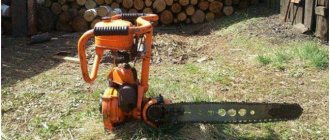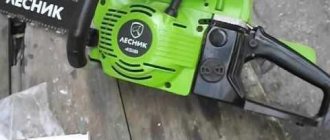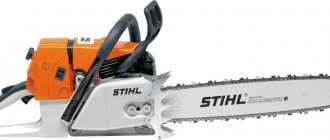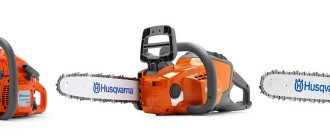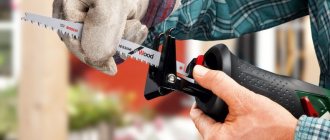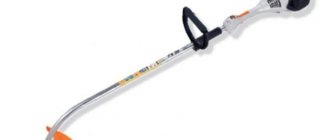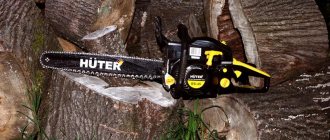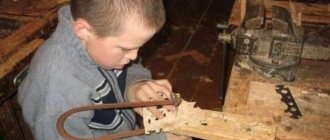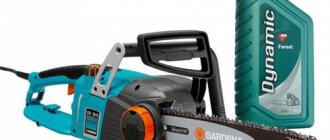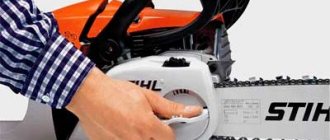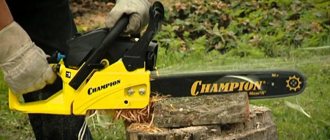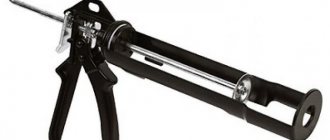Description
The Stanley 1900 pro walk-behind tractor is produced by a German company. Quality control of manufactured products occurs at each stage of device assembly. The manufacturer's warranty for the Shtenli 1900 pro series walk-behind tractor is 2 years.
A photo of the walk-behind tractor is presented below.
This device is equipped with a four-stroke gasoline engine with a power of 18 horsepower. Stanley 1900 pro is used for processing large areas with heavy soil types. Cools the engine thanks to air flow
The Shtenli 1900 pro series starts up using a manual starter.
Overview of the Stanley model range
Stanley gasoline walk-behind tractors
Shtenli 500
Shtenli 500 walk-behind tractor
This is the lightest walk-behind tractor in the model range of the German company Shtenli. It has a gasoline engine with 7 horsepower. The weight of the machine is only 80 kg. To improve stability during heavy work, an additional wheel is installed in front.
Shtenli 900
This walk-behind tractor belongs to the middle traction class and has an 8 hp engine. The weight of Shtenli 900 is 105 kg. Its pneumatic tires are 4x8.
Shtenli 900 walk-behind tractor
This Stanley model is used for cultivating medium-sized agricultural land.
Shtenli 1030
This walk-behind tractor is equipped with a gasoline engine with a power of 8.5 horsepower. Its weight is 120 kg, which is enough to operate heavy attachments.
Shtenli 1030 pro walk-behind tractor
The cutting width of this model is not large - only 90 cm. Because of this, owners note a lot of dirt sticking to them.
Shtenli HP 1100
Shtenli HP 1100 walk-behind tractor
This walk-behind tractor from Stanley is equipped with a gasoline engine with a power of 11 horsepower. It is intended for processing prepared land plots. The gearbox has 3 stages, thanks to which you can control the speed of work in a convenient range.
Shtenli 1100 Pro series
This heavy walk-behind tractor is equipped with a Honda AMS 190F gasoline engine with a power of 14 horsepower. The manufacturer offers two options for these machines: with and without a PTO. This gives buyers a choice. If they plan to use it purely as a cultivator, then they do not need a PTO.
Shtenli 1100 PRO series walk-behind tractor
There is also a Shtenli XXXL model, which has a more organic appearance and a top-mounted fuel tank. The model is equipped with a Honda GX390 gasoline engine with 13 horsepower.
Shtenli 1400 Pro series
Motoblock Shtenli 1400 PRO SERIES
This is a representative of heavy walk-behind tractors, which is equipped with a 14 horsepower gasoline engine and air cooling. Its weight is 177 kg and the tire size is 6.5x12.
Shtenli 1800 Pro series
Shtenli 1800 pro series walk-behind tractor
This is also a heavy walk-behind tractor, which is equipped with a four-stroke engine with a capacity of 18 horsepower from the world famous Japanese company Honda. Its weight is 178 kg, which allows it to process even the hardest rocks and transport heavy loads using trailed equipment.
Shtenli 1900 Pro series with low gear
Shtenli 1900 pro series walk-behind tractor
This is an improved 1800 series walk-behind tractor. Due to the fact that it has a lot of power, the speed of its work and driving is very high, and you have to move behind it at a fast pace. To reduce speed, an additional low gear was installed.
Diesel walk-behind tractors
Recently, diesel models of walk-behind tractors have become increasingly popular, since their engines are considered more durable, have a longer service life, withstand heavy loads and at the same time consume less fuel. The Shtenli company offers the following options for diesel walk-behind tractors.
Specifications
| Manufacturer: | Shtenli |
| Power: | 18 hp |
| Engine's type: | petrol 4-stroke |
| Drive unit: | Gear |
| Forward/reverse gears: | 3/1 |
| Fuel consumption: | 1.5 l/h |
| Processing width: | 900-1100 mm |
| Processing depth: | 150-300 mm |
| Wheel size: | 7 x 12 cm |
| PTO: | Eat |
| Weight | 175kg |
| Dimensions | 1900x1400x900 |
| Transmission | Shtenli Gear Shift 2+ (SGS 3+1) Low gear |
| Guarantee: | 24 months |
| Manufacturer country: | Germany |
What kind of oil to pour into a Stanley walk-behind tractor
Walk-behind tractors "Stenli" belong to small land equipment produced using innovative technologies. Most of the modifications are aimed at professional users who need stability and reliability of the machine.
As the first standard, let’s take the model with the index 1800. This popular rumor is that the “Stanley” walk-behind tractor belongs to the professional category. It is the most popular option on the Russian market, also abroad. The aerodynamic body is designed in a modern, streamlined style. The design is one of the best achievements of the designers of this unit. However, the appearance. This is far from the most important thing that gaming slots have.
This modification has been available for a long time. It features elegant style, practicality and reliability. In constructive terms, the variation is also worthy of all praise. The unit is equipped with a Japanese Honda engine, which provides one of the best performance characteristics among rivals. Today, a number of high-quality German parts are used in its design.
In addition to the massive unit, the Shtenli walk-behind tractor is equipped with a differential and a brake when working in the dark. The machine is characterized by good maneuverability, regardless of the type of soil. Improved cross-country ability is also influenced by the presence of pneumatic wheels of huge diameter, which are supplied as standard. Thanks to this design, there is a chance to cultivate any type of land, including virgin soil. The included ground hooks improve the stability of the equipment, allowing you to work in areas with great depth and grain.
The Shtenli-1800 walk-behind tractor has an improved Shtenli Gear Shift 4.5 type gearbox. It is essentially a modernized box that ensures smooth and precise operation of the gears in any operating mode. Special protection against vibrations eliminates their occurrence on the handle, which greatly simplifies the operation of the equipment over a long period of time. As a result, the operator is less tired and productivity increases even in the most difficult areas.
The design of the unit includes a decompression valve, which is responsible for strengthening the complex of accounting launch programs. Thanks to it, the motor is activated the first time, regardless of temperature changes and duration of inactivity. Our client remains able to conduct accounting (software) controls that are ergonomic and located in comfortable places. This applies to the gas and gear levers, which are located on the handle.
READ Drilling porcelain tiles with a diamond drill
Among the advantages of the Stanli walk-behind tractor, we note the following points:
- The front headlight ensures measured and effective illumination. With all this, the power of the light beam can be adjusted. This solution allows the unit to be operated around the clock, without the need for artificial lighting.
- The elastic control handle is customizable and adjustable to suit the height and build of the operator.
- Large pneumatic wheels with a deep tread pattern can be compared with tractor counterparts. The elements have increased maneuverability and endurance to various types of loads.
- The dry clutch is manually controlled and ensures smooth gear shifting without overloading the unit with high speeds.
- Fasteners are provided for various attachments.
- The design of the machine includes German components, which are covered by a two-year warranty.
As evidenced by the responses, the device in question is a modern walk-behind tractor, distinguished by the highest quality and reliability. It works reliably for a long time without overheating and can be equipped with various attachments. Although, the owners note that first you need to break in the car, as the manufacturer advises. This will allow the parts to get used to each other, improve the work process, which will have a positive effect on the functioning of the entire tool. Also, running-in will allow you to adapt the equipment to the local soil and climate without unnecessary stress on the device.
Content
Oil for walk-behind tractor!!!
Before starting the engine of the Stanli walk-behind tractor in a low gear, you should check the condition of the external and internal parts of the unit. Already today, experts advise to freeze the fuel and oil in the engine. When first started, the engine should run for about 30-35 minutes at idle speed. It is also necessary to check the functioning of the box, namely the switching mechanism. Positions must be entered smoothly and correctly, without significant effort. The same point applies to the gas and clutch assembly.
READ How to Correctly Cut Corners of Ceiling Plinth Video
Initial cultivation of the land using the technology in question is carried out by means of carrying out different types of work (mulching, cultivating, plowing, planting and harvesting crops, and the like). For which the cargo transportation design is intended, the force on the machine should not exceed more than half of the maximum load. Approximately running-in lasts about 14-15 hours, which is quite enough to assess the capabilities and potential of the equipment. After running in, an additional technical inspection of the machine should be carried out.
Below are the technical properties of this unit:
- Power indicator – 18 liters. WITH.
- Low gear – available.
- The drive is gear type.
- Number of gears (forward/reverse) – 2.7/1.
- Fuel consumption – 6.5 l/h.
- Processing width/depth – 1300/300 mm (completely).
- Overall dimensions – 1.8/1.35/0.85 m.
- Weight – 175 kg.
- Wheels – 650/120 mm.
This is another of the most popular modifications of small agricultural machinery produced by. Below are the technical characteristics of this earth machine:
- Type – walk-behind tractor “Stenli-1030”.
- Depth/width of soil treatment – 300/900 mm.
- The rotation of the cutters is in the forward direction.
- The power plant is a four-stroke gasoline engine with one cylinder.
- Power – 8.5 horsepower.
- The gearbox is gear type.
- Front/rear gears – 2.7/1.
- The gearbox is a stepped mechanical unit with reverse.
Buy a walk-behind tractor is easy! HOW TO ASSEMBLE IT?
The performance of the 1800 model is ensured by the Honda unit. It has a volume of 0.4 liters, one cylinder, four strokes, and is fueled with gasoline. It is equipped with a gear-type transmission unit; two speeds are responsible for forward travel, and one gear for reverse. The power of the equipment is 18 horsepower.
Among other characteristics of the unit, the following must be said:
- Length/width/height – 1.9/1.4/0.9 m.
- Weight – 178 kg.
- The largest processing width/depth is 1100/300 mm.
- The capacity of the fuel tank is 6.5 liters.
- Average fuel consumption is about 2 liters. At one o'clock.
Depending on the operating criteria, the control characteristics may slightly increase or decrease.
READ Trimmer patriot how to dilute gasoline with oil
It is necessary to briefly mention the remaining modifications of the Stanli brand with a short description of their features:
- Model 900 (ploughman). This popular rumor unit belongs to the middle class of walk-behind tractors and has support for using attachments. With a cutter diameter of 365 mm, the width of the soil treatment is up to 1.2 meters, the depth. 300 mm. The motor power varies at 8 horsepower, the speed of the cutters is 399 rotations per minute.
- Option 1600 is equipped with a power take-off shaft, the width of the cutter is 1100 mm. The gasoline single-cylinder four-stroke engine has a power of 16 horsepower.
- Modification G-185. This technique is classified as a heavy-duty walk-behind tractor. Processing width/depth – 900/300 mm. Motor power is 10.5 horsepower. The volume of the four-stroke internal combustion engine with electric starter is 573 cubic meters. Cm.
- The variation under the index 500 refers to middle-class walk-behind tractors. With a pair of front gears and one rear speed (reverse), the motor power is 7 “horses”; tillage with a cutter diameter of 356 cm reaches 120 cm in width and 30 cm in depth.
Filling oils into the Shtenli 1900 pro walk-behind tractor
Reviews of the Stanli walk-behind tractors are given above. Judging by them, the equipment in question is a worthy rival to the best Russian and foreign analogues. Additionally, it is necessary to note a wide range of devices in terms of power and configuration, which allows you to select a unit depending on the required volumes and work criteria.
Consumers note the reliability of the device and auxiliary elements, ease of operation of the equipment, and long working period. The price of the unit in question varies from 60 thousand rubles for the newest model, or about 15 thousand for a used modification.
Source
Features of application
If you are the owner of a new Stanley 1900 pro walk-behind tractor, then before you start working on it, you need to assemble the device (in accordance with the user manual) and run it in:
- Fill with fuel and oil;
- Warm up the engine at idle speed;
- Gear shifting should be done smoothly and without much effort;
- When cultivating the soil for the first time, use the machine at half maximum power;
- Upon completion of break-in, change the oil.
User manual
Every owner of a Stanley walk-behind tractor should know the rules for handling the device, the principle of its operation and how to correct basic faults. All information regarding this is contained in the operating instructions. Below are key excerpts from it.
First launch and run-in
When purchased from a store, the walk-behind tractor is supplied with spare parts. It needs to be collected. Usually there are no problems with this, since the entire process is described step by step in the operating instructions.
After assembly, the engine runs-in period begins.
To do this, you need to fill in engine oil and fuel, and just let the walk-behind tractor run in minimum load mode. Most often, owners warm up the engine at idle for 30 minutes, and then plow or mill the soil with minimal load on the engine.
Upon completion of break-in, change the engine oil to remove any dust and small abrasive particles that have accumulated during this time.
Service
Stanley walk-behind tractors are professional equipment intended for long-term use. In order to extend their service life, it is necessary to carry out regular maintenance in accordance with the operating instructions.
Stanley 1900 device
- Unlike many analogues, the Stanley 1900 pro walk-behind tractor has not 3 gears, but 4, one of which is low.
- Many owners of walk-behind tractors with power from 8 to 18 hp. They note the inconvenience of operating the machine and the rapid progress of its operation. A low gear reduces the transmitted torque and allows you to carry out work comfortably.
- Another advantage of the Shtenli walk-behind tractor is the installed anti-vibration system, which allows you to reduce the transmitted vibration to the steering bar.
- The Stanley 1900 Pro walk-behind tractor is equipped with a powerful halogen headlight that illuminates the area at night.
Photo of Shtenli 1900 Pro walk-behind tractor
Service Stanley 1900
- It is necessary to monitor the condition of the Stanley walk-behind tractor and carry out regular maintenance in accordance with the user manual.
- Upon completion of work, be sure to clean the device from any remaining dirt, dust and moisture. If they accumulate for a long time, the walk-behind tractor can quickly begin to rust.
- It is necessary to clean the fuel and air filters every 5 hours of operation, since if they are clogged, the engine will begin to malfunction.
- Engine oil must be changed every 25 operating hours. For this it is recommended to use 10W-30.
- Transmission oil must be changed twice a year: in autumn and spring.
What kind of oil to fill in a MTZ walk-behind tractor with a Honda engine
MTZ walk-behind tractors have established themselves as high-quality agricultural equipment; in combination with the world-famous Honda engine, they have excellent performance characteristics.
For proper operation of the entire device, it is necessary to carry out timely technical inspection, including checking the oil level. What kind of oil should I use? Belorus 08H-09H walk-behind tractors with Honda GX 240, 270, 340 and 390 engines are suitable for oil classified no lower than SG and SF; all-season oil SAE 10W-30 is recommended, but under specific temperature conditions it is necessary to select a special oil.
Owner reviews
Here are the reviews left on thematic forums regarding the operating experience of the Stanley walk-behind tractor:
Kirill:
“I have a plot of 15 acres. I regularly work with cutters and do work with potatoes.
Among the advantages of the Stanley Pro are low fuel consumption, high weight and power, and the presence of a low gear.
But one of the disadvantages is the unclear operating instructions. They probably have a standard one, since half of the details are not indicated in it at all. Low quality metal. Many bolts do not hold and I have already replaced almost all of them with normal ones. The wires are not secured in any way and can be easily torn off.
There were problems with the ignition system, I changed the spark plug, and now it starts normally.
The impression is twofold. The quality is clearly not German, but it’s about worth the money.”
Oil in the walk-behind tractor gearbox?
Good day!
The instructions for the Neva say to pour TEP-15 oil. In the nearest stores there is no such thing and have not heard of it. I saw a recommendation on the forum to pour any GL-5. But it also varies. For example, if you take Lukoil, then: SAE 75W-90 SAE 85W-90 SAE 80W-90
I compared the parameters according to GOSTs - it seems that the closest thing to TEP-15 is GL-5 SAE 75W-90. Since I’m not good at transmission oils, please tell me which one is better to use.
In general, there are also doubts about the GL-5.
Here "> there is a table "Compliance of gear oil brands according to this standard with previously adopted regulatory and technical documentation, foreign classifications and GOST 17479.2 "
According to it, TEP-15 is GI-2 (by the way, why GI and not GL is unclear)
I found another document:
API classification of gear oils by application:
GL-1 Spur, worm and helical bevel gears in low speed and load applications. Mineral oils without additives or with antioxidant, antiwear and antifoam additives without extreme pressure components.
GL-2 Worm gears operating under GL-1 conditions, but with higher requirements for anti-friction properties. May contain an anti-friction component.
GL-3 Conventional helical bevel gear transmissions operating under moderately severe speed and load conditions. They have better anti-wear and extreme pressure properties than GL-2.
GL-4 Automotive hypoid transmissions operating in conditions of high speeds with low torques and low speeds with high torques. The presence of highly effective extreme pressure additives is mandatory.
GL-5 Automotive hypoid gears operating under conditions of high speeds and low torques, under the action of shock loads on gear teeth - at high sliding speeds. Must contain a large amount of sulfur-phosphorus-containing extreme pressure additive.
GL-6 Automotive hypoid gears with increased vertical displacement of gear axes, i.e. operating at high speeds, shock loads and high torques. Contains more sulfur-phosphorus extreme pressure additives than GL-5 oils.
As I understand it, GL-2 and GL-5 oils are very different. So what should you pour? Explain to the lamer
You can pour any oil corresponding to GL-5 into the walk-behind tractor gearbox, and the viscosity is at your discretion, 75W90 I think up to -30C.
The gearbox parts of the walk-behind tractor do not experience heavy loads, so any transmission oil can be poured. If the seals are good, pour Lukoil TM-4 80W85, if they are bad, pour thicker oil (the ones you already mentioned) or replace the seals. In the gearboxes of walk-behind tractors of the “Luch” and “Cascade” types, lubrication occurs by splashing, so the thinner the oil, the better. If you use the walk-behind tractor frequently in winter, don’t buy the “liter” of semi-synthetic 75W90.
Trilliput wrote: If you frequently use a walk-behind tractor in winter, don’t buy the semi-synthetic 75W90 litrushka.
What's the difference with min. 75W90?
Message from vadim 08355 What is the difference with min. 75W90?
Good question. Mineral oil cannot provide such a temperature range - either winter oil SAE 75W or summer oil SAE 90. I emphasized the inappropriateness of using expensive synthetics.
But this is a bad question for you.
Dizzy78 wrote: I compared the parameters according to GOST standards - it seems that the closest thing to TEP-15 is GL-5 SAE 75W-90.
Oh my. This is a walk-behind tractor! Post No. 4 can be safely included in any instructions. Word by word.
Trilliput, thanks for the detailed answer!
vadim 08355, try to imagine that not all users of garden equipment are mechanics or, at worst, engineers. I formulate the questions due to my understanding of this topic; the properties and composition of oils are deeply uninteresting to me. If the equipment manufacturer, in the instructions for “amateur” garden equipment, recommends using consumables that, frankly, are not very accessible in retail stores, and also operates with GOSTs unknown to the “general public” (absolutely ignoring international classifications), then this is a question for the manufacturer, not to the user.
Dizzy78 wrote: If the equipment manufacturer, in the instructions for “amateur” garden equipment, recommends using consumables that are, frankly speaking, not very accessible in retail stores, and also operates with GOSTs unknown to the “general public” (absolutely ignoring international classifications), then this is a question for the manufacturer , not the user.
Dizzy78. Sorry. You're right.
Dizzy78 wrote: I am deeply uninterested in the properties and composition of oils.
And I'm very interested. Although I am not a motor mechanic or an engineer. I once worked as a car mechanic. But not for long. Regarding the oils, I would skid. Interesting topic. The bad question meant synthetic 75W90. Why semi/synthetic? That's all. It’s like viscosity is viscosity, and composition is composition. In general, I shot at the wrong gate. Once again, sorry.
vadim 08355 wrote: And I’m very interested. Although I am not a motor mechanic or an engineer. I once worked as a car mechanic. But not for long. Regarding the oils, I would skid. Interesting topic. The bad question meant synthetic 75W90. Why semi/synthetic? That's all. It’s like viscosity is viscosity, and composition is composition. In general, I shot at the wrong gate. Once again, sorry
Also sorry for the harshness
As for why I suggested semi-synthetic 75W90, I’ll explain from the point of view. amateur Because The manufacturer didn’t give me anything other than GOST, and I have practically no knowledge of oils, I stupidly took 2 tables: “> - physical and chemical indicators of transmission oils, respectively.
with GOST standards (Table 1) » > - Transmission oils: “LUKOIL-TM” and compared according to available indicators. It turned out that the 75W90 has the closest characteristics to TEP-15. I confess, I didn’t pay any attention to the composition at all, I thought that GL-5 was all semi-synthetic (now I know what the differences are, I won’t ask such a bad question a second time). Trilliput explained why to dance when choosing.
What kind of oil to pour into a walk-behind tractor engine
In order for the walk-behind tractor to work flawlessly for a long time, it must be properly maintained and operated. Oil is a key factor in keeping an engine running. We’ll try to figure out what kind of oil to pour into a walk-behind tractor engine on this page of the site.
The most correct recommendation for selecting oil will be the recommendation of the engine manufacturer for the walk-behind tractor. Therefore, we will familiarize ourselves with the operating instructions of the main manufacturers of engines for walk-behind tractors and provide excerpts from the instructions.
The choice of motor oil, like any other type of oil, depends on two main parameters - operational category and viscosity class.
CLASSIFICATION OF OIL GRADES API classification by operational categories (American Petroleum Institute). See more details here
CLASSIFICATION OF OIL GRADES BY VISCOSITY SAE classification (Society of Automotive and Transportation Engineers). See more details here
Winter - with the letter W (Winter). Oils that meet these categories are low-viscosity and are used in winter - SAE 0W, 5W, 10W, 15W, 20W, 25W
Summer - without letter designation. Oils that meet these categories are highly viscous and are used in summer - SAE 20, 30, 40, 50, 60.
All-season - at the moment, universal oils are most widely used, which are used in both winter and summer.
Such oils are designated by a combination of winter and summer ranges: 5W-30, 10W-40
What kind of oil to pour into the shtanli walk-behind tractor
Over time, any citizen who uses a walk-behind tractor is interested in the question of what oil to pour into the walk-behind tractor, as well as how to do it.
It is worth paying increased attention to this issue, because the service life of the walk-behind tractor depends on the correct choice. First you need to read the annotation about the device model used. This place indicates what oil to pour into the walk-behind tractor and in what quantity. These rules should be strictly followed. First you need to find out which walk-behind tractor is better. If you choose a device that runs on diesel fuel, then you must use diesel oil. Today, we evaluate the time of year because summer and winter remedies meet.
It happens that a person purchases a gasoline walk-behind tractor without an annotation.
During operation, the motor of a walk-behind tractor is constantly subjected to severe loads.
There is a huge selection of technical characteristics of oils. What kind of oil should I put in my walk-behind tractor? When choosing, you need to find out about viscosity and quality. These two indicators are the main ones. The first step is to choose which walk-behind tractor is best to use for this type of product, in addition to the climate. You will find the answers to all these questions on the motor water label.
- SAE. Its main indicator is resistance to various temperature changes. It is used not so much for the summer, but for the winter period. How to find? First you need to look at the number in front of the letter W. The lower its value, the more easily it is adapted to cool temperatures. The smallest value is 0W. If there is no such letter, it means the oil was created for summer. The more important it is, the better the quality.
- API. This value characterizes the operating conditions. There are two types of them: diesel and gasoline. The letter values indicate the quality of the oil, and additionally where it needs to be poured: into a gasoline or diesel walk-behind tractor. Also, its type depends on the number of clock cycles. In other words, the number 3.5 is an engine with 2 strokes, etc. Some brands are used for both 2 and 4 strokes, called combined. The next indicator is the letter value of the EU, which means energy conservation. Oil efficiency is indicated in Roman numerals; the higher they are, the better it is.
- ASEA. Indicates the initial quality of the material. The oil is used not only by passenger cars, but also by trucks running on diesel fuel. Upon completion there is usually a number. If its value is the highest, then the vehicle operates under strict criteria.
- CCMC. This indicator is rarely used. He indicated what types of cars the oil was suitable for.
- MIL-L. This indicator is used in military terminology and is divided into two parts. Code 2104 indicates that the walk-behind tractor is diesel, and 46152 is gasoline.
- GOST 17479.1-85. This is the last line indicating the viscosity of the oil. Upon completion, there are different letters and numbers indicating the type of fuel. If they are absent, then the lubricant is universal.
When purchasing a walk-behind tractor, you must remember that its long-term operation depends not only on replacing consumables, parts, tightening the necessary nuts, but also on timely changing the oil in the walk-behind tractor.
The durability and performance of the equipment depends on how correctly to choose motor oil for walk-behind tractors. The question arises, what kind of oil to pour into the walk-behind tractor engine, how to replace it or check the level.
Peculiarities
Motoblocks of the “Shtenli 1900 Pro” model are in the leading positions of their family, as they are equipped with a powerful 14 liter four-stroke gasoline engine. With. and 18 l. s., as well as a fairly well-thought-out gearbox. The equipment has a gear drive, 3 forward and one reverse speed. Weighing 175 kilograms, the unit is characterized by a processing width of 90-110 cm and a depth of 15 to 30 centimeters. A walk-behind tractor with a low gear facilitates the comfortable performance of a variety of jobs.
The advantages of the machine include the installed anti-vibration system, which helps reduce vibrations on the steering hose. "Shtenli 1900 Pro" has a powerful halogen headlight, thanks to which it can be used in the dark.
The unit has an optimal length of a hexagonal shaft, a cast-iron gear reducer with a bevel gear. Also, the advantages of the unit are the presence of a convenient glove compartment, as well as the ability to adjust the handle to suit any height.
Technical characteristics of the walk-behind tractor
Equipment arrives at sales points in disassembled packaging. The walk-behind tractor is assembled by personnel of specialized stores. After this, the completeness of the goods and the availability of technical and financial documentation are checked. In order to ensure the functionality of the product, it is tested. The engine is started, the headlight, clutch, correctness and precision of gear shifting are checked. The equipment is presented to the potential buyer already assembled.
The Shtenli 1030 Pro walk-behind tractor has the following technical characteristics:
- engine brand - Honda AMS-192 FB, gasoline, four-stroke;
- working volume - 425 cm³;
- power - 18 hp;
- speed - 3700 rpm;
- cooling - air, forced type;
- starting - manual, with the ability to install a battery and electric starter;
- transmission - cast iron gear reducer with disc clutch;
- power take-off shaft - on the front side of the unit;
- number of gears - 3 (2 forward and 1 reverse);
- maximum speed forward/backward - 16/4 km/h;
- fuel tank capacity - 6.0 l;
- engine oil tank capacity - 1.3 l;
- fuel consumption - 1.2-1.5 l/h;
- wheels - rubber pneumatic 6.00-12 with a powerful tread;
- weight without additional options with full refueling - 182 kg;
- Dimensions (length/height/width) - 2300x1400x920 mm.
The Shtenli 1100 walk-behind tractor is capable of loosening the heaviest soil to a depth of up to 35 cm. The plowing depth is adjusted by the coulter in 50 mm increments. The working width is 80-110 cm. When working with a lower gear, overheating of the motor is eliminated due to the presence of a special low oil level sensor. When a critical temperature is reached or the oil level drops, the automatic switches off the engine.
Correct operation and maintenance
Each user of a walk-behind tractor must be able to use it correctly. To do this, each product is accompanied by an instruction manual, which describes in detail the principles of its use. Replacing the clutch, adjusting the carburetor, adjusting the plow, unlocking the wheels are simple processes that every owner can do.
The basic rules for operating the Shtenli 1900 Pro are as follows:
- running-in for 8 hours, while the engine load should be at 2/3 power;
- in the winter period of the year it is worth using synthetic oil for the walk-behind tractor, and in the summer - semi-synthetic;
- oil must be added after every 50 operating hours;
- for storage, the unit must be left with a previously emptied tank and oil sump;
- the machine must be stored in a room with a positive temperature;
- Spark plugs and oil filters must be cleaned or replaced annually.
Troubleshooting
The most common problems encountered by walk-behind tractor users.
- Reduced engine power . The reason for this situation could be a clogged carburetor, cylinder, muffler, air hose or gas hose, so they should be thoroughly cleaned. In a situation where a decrease in power occurred after long-term storage, it is necessary to start the unit and run it idle for a while. If there is no compression, it is worth replacing the piston rings or cylinder.
- Lack of engine response to starting . The reason for this situation may be the tilt of the engine, which should be placed in a horizontal position. If the filter or tank opening is clogged, they should be cleaned. The problem may be hidden in the spark plug; to do this, it is worth checking the wires, as well as the stop button. Don't forget about cleaning or replacing candles.
- The engine operates intermittently and stalls . To begin with, the engine should be warmed up well. After this, clean the spark plugs or replace the magneto.
- The idle speed is unstable . The reason for this malfunction may be based on the large gap between the cover and the gearbox. In order to fix the problem, it is worth making the gap smaller.
- Smoke from the walk-behind tractor . This situation may arise due to poor quality gasoline or excessive tilt of the unit.
- The starter makes noise and the cord falls out . The squealing noise of the machine may be due to excessive grease on the balls, which should be cleaned thoroughly. If you hear the starter popping, then the problem may lie in the fact that the power system cannot perform its tasks efficiently.
To improve the functioning of the walk-behind tractor, it is necessary to remove debris from the valve and air filter.
Attachments
The complete set of the walk-behind tractor, in addition to the unit itself, includes rubber wheels, cutters, a universal hitch, a step, a set of tools and spare parts, and instructions. Each owner of the Shtenli 1900 Pro has the opportunity to improve the unit by adding attachments to it.
The most common attachments for walk-behind tractors:
- hillers;
- plows;
- potato diggers;
- potato planters;
- trailers;
- adapters with seat;
- water pumps;
- ground hooks;
- seeders;
- additional cutters;
- metal wheels;
- rotary mowers.
Attachment overview
Stanley walk-behind tractors have gained popularity due to the fact that they are able to support work with a wide range of attachments. Every owner should be familiar with the capabilities of their machine in order to get the most out of it.
Milling cutters
This is a basic hitch that is available to every owner of a Stanley walk-behind tractor. It is used to turn over the top fertile layer of soil and further increase soil fertility. During operation, the cutters are installed instead of standard pneumatic wheels.
Milling cutters for walk-behind tractor
Plow Mole
Reversible plow
Plow
This attachment is used with Stanley walk-behind tractors when it is necessary to plow dense rocky soils. The plow sinks into the ground and allows you to hold the walk-behind tractor in a stable position.
Mower and rake
Stanley walk-behind tractors can help in clearing weeds and unwanted vegetation from the area by connecting the rotary mower to the PTO. The mower is capable of cutting even coarse-stemmed plants and medium-sized shrubs. The advantage of rotary mowers is that when hitting a stone, the blades do not break off, but turn in the other direction, maintaining their integrity.
Rotary mower
Tedder rake Solnyshko-2 r
Mechanical rake “Sun” -3 rub.
After mowing, many rural residents leave the grass to dry and then harvest it as winter hay for their livestock. You can connect a rake to the Stanley walk-behind tractors and quickly collect the grass.
Potato digger and potato planter
Potatoes are in demand among the residents of our country. At the same time, planting and harvesting work takes a lot of time and requires significant physical effort. If you are the owner of a Shtenli walk-behind tractor, then this task can be completed independently by connecting the appropriate attachments.
Potato digger
Potato digger for walk-behind tractor KKM-1
Potato planter KS-12
The most common version of a potato digger is a screening machine. The potato digger picks up a layer of soil at a level of 20 cm, along with the fruits, and then uses a rumble to break up large rocks of soil, leaving only root crops on the surface.
